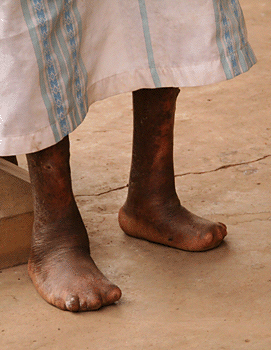Scientists Develop New, Simple Test for an Ancient Scourge
Thursday, February 21st, 2013February 21
Scientists at the Infectious Disease Research Institute of Seattle announced that they had developed a fast and simple test to determine if a patient has leprosy (also known as Hansen’s disease). In the past, the test for leprosy was complex, requiring a doctor to cut open a suspicious nodule (lump) on a patient’s skin and search the tissue under a microscope for the cause of leprosy–a rod-shaped bacterium called Mycobacterium leprae. The new test requires only a drop of blood from the patient, which is then placed into a small plastic testing device connected to a smartphone. A doctor can read the test results on the phone’s screen in seconds. This simple test can also be performed in remote and rural areas by non-physicians. The new test has a huge advantage over former testing methods–that is, people who show no symptoms of leprosy can still be tested.

Leprosy can cause crippling deformities of the hands and feet. A new test that can diagnose people at much earlier stages of the disease holds out the hope that such advanced cases of leprosy may one day be eliminated. (© Thinkstock)
Scientists are not certain how leprosy is spread, but close and repeated contact with an infected person is likely necessary. Most people infected with the leprosy bacteria do not develop symptoms, as their immune system fights the disease. It usually takes from 3 to 5 years for symptoms to develop in a person whose immune system is unable to fight the disease, but it can take as long as 10 years. The first symptoms of leprosy are usually white or reddish patches of skin, called skin lesions. These lesions are often initially misdiagnosed as some common skin disease, such as eczema. When leprosy develops further, a person experiences a loss of feeling in the skin lesions and thickened nerves. The nerves can become severely damaged, causing weakness in the hands and feet. As a result, the fingers and toes may curl inward. Eventually, a patient’s body may absorb the calcium from the bones, giving the appearance that fingers or toes have “fallen off.” The skin may also thicken, and dark nodules may appear on many parts of the body. Once nerve damage has occurred in a patient, it cannot be reversed, which is why misdiagnosis at the early stages of the disease is so tragic.
The disease leprosy is ancient, at least 2,000 years old and probably older. The lesions and deformities of leprosy are so terrible that people who have suffered with the disease have been shunned by society and, often, forced to live in colonies away from other people, known as leprosariums. Since the 1940′s, antibiotics have been available to treat patients with leprosy. Today, patients are usually treated with a combination of three antibiotics. The drugs, if taken faithfully, can cure leprosy. Two former leprosariums in the United States still have a few former patients living there–Kalaupapa, on the island of Molokai in Hawaii, and Carville in Louisiana. These former patients are no longer quarantined at the sites, but some of the elderly people who had lived there for decades chose to continue living there after the sites were closed to new patients.
Around 250,00 people worldwide are diagnosed with leprosy each year, according to the World Health Organization. It is uncommon in the United States, but the disease still occurs in other regions, including South and Southeast Asia and some parts of Latin America.
Additional World Book articles:


